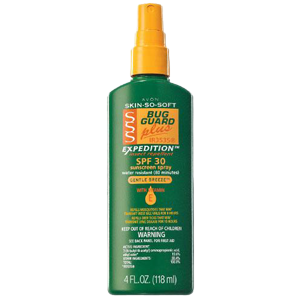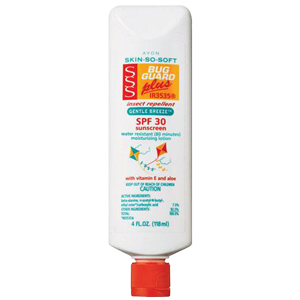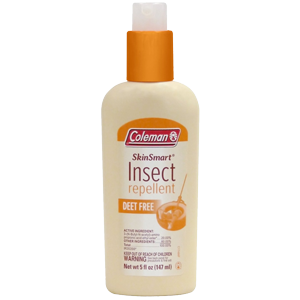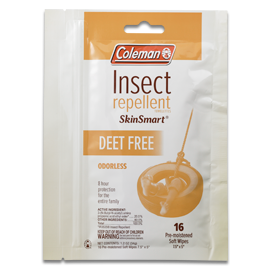IR3535 is an active ingredient found in a variety of insect repellent products. 20% formulations provide complete protection from insect bites for at least 6 hours. It has been used by consumers for over 35 years without a single reported adverse affect.
History Cosmetic Properties Efficacy Mode of Action Toxicity
 |
 |
 |
 |
|
| Product Name | Avon Skin-So-Soft | Avon Skin-So-Soft | Coleman SkinSmart | Coleman SkinSmart |
| Price | $8 | $5 | $5 | $7 |
| Size | 4 ounces | 4 ounces | 5 ounces | 16 wipes |
| Application | Pump Spray | Lotion | Pump Spray | Soft Wipes |
| Use On | Skin | Skin | Skin | Skin |
| Active Ingredients | IR3535 | IR3535 | IR3535 | IR3535 |
| A.I. Concentration | 19.6% | 7.5% | 20% | 20% |
| Duration | 8 hours | 2 hours | 8 hours | 8 hours |
| Product Label | ||||
| MSDS | ||||
| FleaScore | ||||
| Reviews |
- Prices are approximations based off of Amazon.com prices at the time of publishing.
- FleaScores are based off of product details (price, size, active ingredients, etc), as well as reviews aggregated from 3rd party sources.
What is IR3535?
IR3535 stands for insect repellent 3535. It’s the code name that Merck KGaA uses for ethyl butylacetylaminopropionate (EBAAP). IR3535 is a human-grade, broad-spectrum, synthetic insect repellent. It’s meant to be topically applied to exposed skin. Technical grade IR3535 is a liquid formula composed of 98% 3-[N-Butyl-N-acetyl]-aminopropionic acid, ethyl ester and 2% inert ingredients.
IR3535
Chemical Overview
| Chemical type | Biopesticide – insect and acarid repellent |
| Developer | Merck KGaA |
| Developed in | 1970 |
| Common names | Ethyl ester, EBAAP, EBAP, Merck 3535, OMS 3065 |
| Trade name | IR3535® |
| INCI name | Ethyl butylacetylaminopropionate |
| IUPAC names | Ethyl 3-[acetyl(butyl)amino]propanoate 3-[N-Butyl-N-acetyl]-aminopropionic acid, ethyl ester |
| CA name | beta-alanine, N-acetyl-N-butyl-, ethyl ester/carboxylic acid |
| CAS No. | 52304-36-6 |
| Molecular formula | C11H21NO3 |
| Molecular mass | 215.29 g/mol |
| Physical state | Liquid |
| Odor | Nearly odorless |
| Color | Colorless to slightly yellow |
| Molecular Structure |  |
History
The Development of IR3535
IR3535 was developed in the early 1970s by Merck KGaA, a German pharmaceutical and chemical company. It was created by mimicking the molecular structure of compounds with known repellent properties. The chemical structure of IR3535 is based upon β-alanine, a naturally occurring beta amino acid.
Consumer Availability
IR3535 repellents became commercially available in Europe in 1979. 10 years later, it was used throughout Asia. In 1999, IR3535 was registered with the Environmental Protection Agency (EPA) and was subsequently introduced to the United States consumer market. There, it’s achieved commercial success in Avon Skin-So-Soft products. IR3535 is also sold in Coleman SkinSmart repellents and Bullfrog sunscreens.
Today, IR3535 is used in over 150 repellent products world-wide. It can be found in lotions, pump-sprays, aerosols, roll-ons, sticks, powders, gels, creams and wet-wipes. It’s also sometimes sold in sunscreen. Sprays can be formulated with up to 20% IR3535, and lotions can contain up to 10% IR3535. Although few American products contain IR3535, it’s captured a large market share due to its compatibility with skin and safety profile. There’s increasing demand for safer alternatives to DEET.
Registration & Recommendations
In 1997, the EPA’s Biochemical Classification Committee classified IR3535 as a biochemical. Although IR3535 is synthesized, the compound is functionally and molecularly identical to naturally occurring β-alanine, which targets pests via a non-toxic mode of action. Biopesticides are derived from plants or animals and are considered safer than synthetic compounds.
In 1999, IR3535 was registered with the EPA. In 2001, the World Health Organization (WHO) stated IR3535 repellents were safe and effective for personal use. In 2008, the Centers for Disease Control (CDC) added IR3535 to their list of approved insect repellents for preventing the transmission mosquito-borne illness, such as West Nile Virus.
Cosmetic Properties
IR3535 offers unique advantages over other repellents like DEET or picaridin. It’s extremely safe, without a single incident of toxicity or adverse effect. In addition, IR3535 has favorable cosmetic and aesthetic qualities. It’s colorless, lightweight and has a non-greasy feel. It becomes largely undetectable on skin after it dries. IR3535 is the only repellent with virtually no odor. It also won’t melt plastics like DEET.
Efficacy
Generally, IR3535 provides good protection from insect bites and is comparable to other repellents. However, it sometimes fails at low concentrations. How effectiven it is depends upon the formulation and the targeted species of pest. It’s believed that any shortcomings in the repellent power of IR3535 can be overcome through synthesis of new derivatives.
Targeted Arthropods
IR3535 is a broad spectrum repellent. It repels a variety of biting arthropods including mosquitoes, flies, chiggers, midges, fleas, body lice and ticks. Unlike DEET, IR3535 has also been shown to be effective against head lice, bees and wasps.
Effective Duration
20% formulations of IR3535 have been shown to be effective for up to eight hours. IR3535 lasts longer against ticks than against mosquitoes.
Fig 1 Minutes (y-axis) it takes mosquitoes to bite humans treated with different IR3535 repellents (x-axis).
In one field evaluation against mosquitoes, five formulations of IR3535 were tested (see Fig 1). All the repellents remained on the skin for at least 2 hours. They provided lasting protection, with an average of six hours before the first bite.
Against Mosquitoes
Numerous studies have been with IR3535 against mosquitoes. Those using 20% formulations of IR3535 have observed repellency effects near identical to DEET and picaridin. When formulations of IR3535 drop below 10%, the repellent effect is diminished. Low concentrations of IR3535 consistently under-perform other repellents, sometimes lasting less than 30 minutes.
Fig 2 Percent mosquito repellency (y-axis) provided by different insect repellents across 6 hours (x-axis).
In a six hour field study in Everglades National Park, the efficacy of 25% DEET, IR3535, and picaridin were compared against mosquitoes (see Fig 2). The mean repellency was 94.8%, 88.6% and 97.5%, respectively. The average complete protection time was 5.6 , 3.0 and 5.4 hours.
Against Ticks
IR3535 is effective at repelling ticks for between 7 to 12 hours, as evidenced in studies done against black legged (Ixodes scapularis) and lone star ticks (Amblyomma americanum).
Fig 3 Hours (y-axis) of complete protection from mosquito and tick bites provided by different IR3535 repellents (x-axis).
In the field study against black legged ticks, three concentrations of IR3535 were applied to 20 human subjects — a 10% lotion, a 20% pump spray, and a 20% aerosol. All three formulations protected the test subjects for at least 7 hours (see Fig 3).
Against Sand Flies
In equal concentrations (10%), IR3535 slightly outperforms DEET against sand flies.
Impregnating Fabrics
Recently, IR3535 has been used to impregnate fabrics. This is done to manufacture insect-repelling bed nets. Fabrics specially treated with IR3535 can prevent 100% of insects from landing and biting for up to 23 weeks.
Mode of Action
Being a biopesticide, the mode of action of IR3535 is non-toxic. However, the exact mechanism of action of IR3535 (and other repellents) is poorly understood. In general, repellent molecules seem to affect olfactory (smell) and gustatory (taste) receptors.
Olfactory Receptors
IR3535’s repellent effect occurs at a distance, which indicates interaction with olfactory sensilla. While IR3535 affects odorant receptors, they aren’t necessarily the same receptors affected by DEET and other repellents. Repellents don’t share a common mode of action.
IR3535 doesn’t use aromatic compounds to mask the bodily attractants. Instead, it paralyzes the sensing system of insects and prevents them from recognizing a host. IR3535 has a dual effect on olfactory receptors, both inhibiting (antagonism) and activating (agonism) them. As a result of this olfactory modulation, the arthropod can no longer detect attractant cues from a host. It has been shown that IR3535 may also be synergistic, hyper-activating the receptors and causing confusion in host detection.
Gustatory Receptors
Insect repellents also stimulate gustatory receptor neurons in mosquitoes, resulting in a feeding or biting deterrent response. This feeding deterrent response also affects insect larvae.
Insecticidal Effect
Low concentrations of IR3535 do not cause knockdown or mortality in mosquitoes. However, it has been shown to affect flight behavior (irritancy). The irritant effect may be caused by neurotoxicity.
Toxicity
The safety record of IR3535 is unblemished. Since its introduction to consumer markets in 1979, there has not been a single report of adverse effects. IR3535 has been tested for numerous toxicity risks and has shown an excellent skin tolerance and general safety. The WHO has classified IR3535’s toxicity as ‘U’, “unlikely to present acute hazard in normal use”. The EPA has stated that IR3535 is practically non-toxic to mammals and humans, including infants and children.
IR3535
Toxicity Data
| Acute Dermal Exposure | III | EPA Fact Sheet |
| Acute Oral Exposure | IV | IR3535 MSDS |
| Acute Inhalation Exposure | IV | WHO Fact Sheet |
| Primary Skin Irritation | IV | EPA Repellent Safety |
| Primary Eye Irritation | II | CDC Repellent Safety |
| Dermal Sensitizer | no | AAP Repellent Safety |
| Carcinogen | no | |
| Fish | n/a | |
| Aquatic Invertebrates | n/a | |
| Birds | n/a |
Biopesticide
IR3535 is a biopesticide derived from plants or animals. Biopesticides are considered safer and less toxic than conventional synthetic compounds, such as DEET or picaridin.
Acute Toxicity
IR3535 has a low overall toxicity for all routes of exposure. It’s slightly toxic for dermal exposure, and practically non-toxic when swallowed or inhaled. However, IR3535 can be an irritant to the eyes. It doesn’t cause skin irritation and isn’t a dermal sensitizer.
The main hazards relate to eye and skin irritation. Skin irritation has never been observed in humans, only animals. Eye exposure can be prevented, and the risk was considered acceptable by WHO. Upon exposure to eyes, immediately rinse eyes with plenty of water and seek medical advice.
Environmental Toxicity
There’s no data on the ecotoxicity of IR3535. However, the active ingredient is unlikely to pose risks to the environment in normal use.
Carcinogenicity
There are no findings of any carcinogenic or genotoxicic effects. This data, combined with the fact that IR3535 is analogous to a naturally-occurring substance, make it unlikely that the compound will cause cancer.
Skin Absorption & Excretion
In animal studies, IR3535 was shown to have a skin absorption rate of around 30% of the applied dose. In humans, the skin absorption rate is lower, around 13.3% is the worst case scenario (skin penetration enhancers were used). When IR3535 is absorbed by skin, it is rapidly metabolized into a free acid and is excreted through urine. 100% of the absorbed IR3535 is removed from the body through urinary excretion. This is due to the chemical’s low molar weight and high water solubility.
Use on Children
Since IR3535 has low toxicity and is analogous to β-alanine, the EPA has determined that there is reasonable certainty of no harm for the general population, as well as infants and children.



You must log in to post a comment. Log in now.